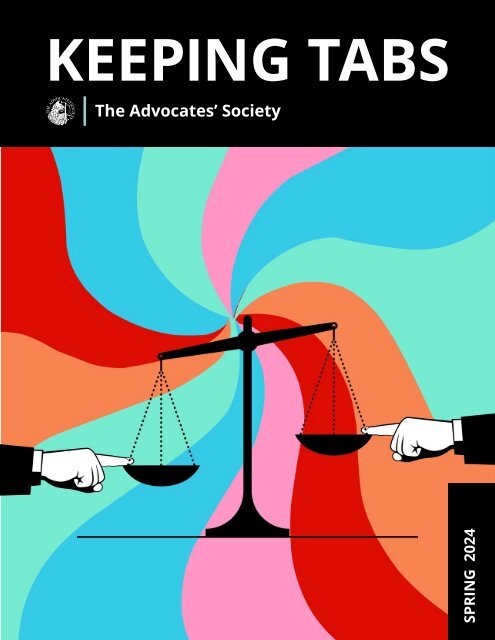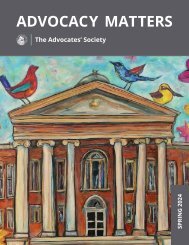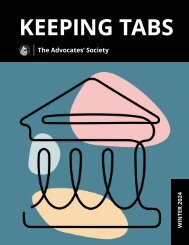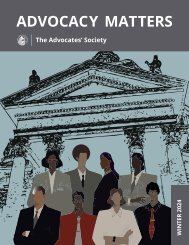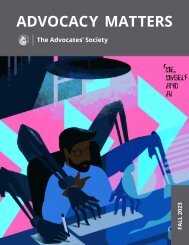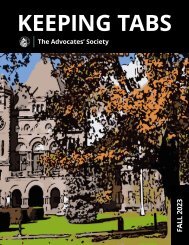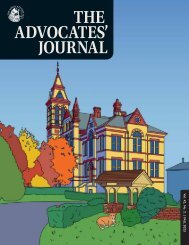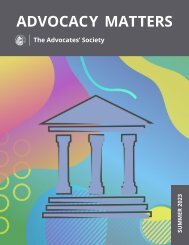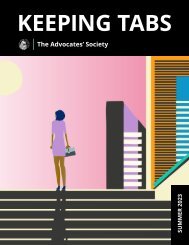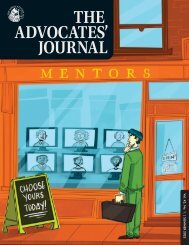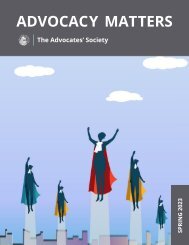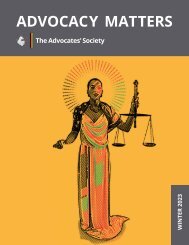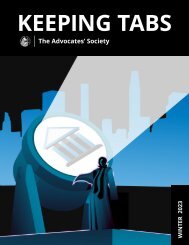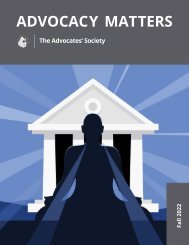Keeping-Tabs-Spring-2024
Stay up-to-date on news and events from our Young Advocates' Standing Committee (YASC) with Keeping Tabs.
Stay up-to-date on news and events from our Young Advocates' Standing Committee (YASC) with Keeping Tabs.
Create successful ePaper yourself
Turn your PDF publications into a flip-book with our unique Google optimized e-Paper software.
KEEPING TABS<br />
The Advocates’ Society<br />
SPRING <strong>2024</strong>
CONTENTS<br />
05<br />
08<br />
10<br />
13<br />
17<br />
22<br />
24<br />
Chair Chat<br />
Chris Kinnear Hunter (he/him), Torys LLP<br />
A Cheat Sheet for Commercial Litigators: Key<br />
Procedural Differences Between Lien Actions and<br />
Other Actions<br />
Cassie Chaloux (she/her), WeirFoulds LLP<br />
In Favour of Efficiency: A Comment on Conditional<br />
Certification in Class Action Proceedings and<br />
Vecchio Longo Consulting Services Inc. v Aphria Inc.,<br />
2021 ONSC 5405<br />
Tom Russell (he/him), Stieber Berlach LLP<br />
Arnup Cup Report<br />
Tomislav Miloš (he/him), MMW LLP<br />
Practice Pitfall: Avoiding a “Handley” Stay Motion<br />
Robert Stellick (he/him), Adair Goldblatt Bieber LLP<br />
Judgment and Restraint: Litigating Against the<br />
Self-Represented<br />
Sarah E. Naughton (she/her), Cunningham, Swan, Carty, Little &<br />
Bonham LLP<br />
Interview with Abdalla Barqawi (he/him), Conway<br />
Baxter Wilson LLP/s.r.l.<br />
Compiled by Ali Háji (he/him), Ricketts Harris LLP<br />
More information is available on the<br />
TAS mentoring website page.<br />
TAS Junior Members are automatically<br />
signed up. Click here to set up your<br />
profile today!<br />
Editor: Eric Blay (he/him), Stikeman Elliott | eblay@stikeman.com<br />
Deputy Editor: Julie Mouris (she/her), Conway Baxter Wilson LLP/s.r.l. |<br />
jmouris@conwaylitigation.ca<br />
<strong>Keeping</strong> <strong>Tabs</strong> Editorial Team: Katrina Crocker, Henein Hutchison Robitaille LLP, Lisa Delaney (she/her), Cox & Palmer, Aly Háji (he/him), Rickets Harris LLP, Glynnis<br />
Hawe, Paliare Roland Rosenberg Rothstein LLP, Karlson Leung (he/him), Ministry of the Attorney General, Crown Law Office and Jean-Simon Schoenholz, Norton Rose Fulbright LLP<br />
2<br />
2 3<br />
Want to mentor? Opt-in to be a mentor<br />
on your TAS member profile.<br />
The Young Advocates’ Standing Committee (“YASC”) is a standing committee of The Advocates’ Society with a mandate to be a voice for young advocates (advocates<br />
who are ten years of call or fewer) within the Society and within the profession. We do this through networking/mentoring events, by publishing articles by and<br />
for young advocates, and by raising issues of concern to young advocates as we work with the Society’s Board of Directors. The opinions expressed by individual<br />
authors are their own and do not necessarily reflect the policies of The Advocates’ Society.
WHAT’S COMING UP @ TAS<br />
(Click on the program to learn more)<br />
MAY 7<br />
Construction Law<br />
Advocacy (Ontario)<br />
MAY 8<br />
Questioning for Family<br />
Lawyers<br />
MAY 8<br />
Questioning for Family<br />
Lawyers Skills Workshop<br />
CHAIR CHAT<br />
MAY 8<br />
Young Advocates’<br />
Speed Mentoring<br />
(Toronto,ON<br />
In Person)<br />
MAY 9<br />
The John P. Nelligan<br />
Award for Excellence<br />
in Advocacy Dinner<br />
(Ottawa, ON,<br />
In Person)<br />
MAY 15<br />
The Art of Settlement<br />
(National, CA, Via<br />
Zoom)<br />
(Ontario, Via Zoom)<br />
MAY 9<br />
First Time in the<br />
First Chair<br />
(BC, Via Zoom)<br />
MAY 15<br />
Mid-Career Women’s<br />
May Mixer<br />
(Toronto, ON, In<br />
Person)<br />
(Ontario, Via Zoom)<br />
MAY 14<br />
Artificial Intelligence for<br />
Litigators: AI in Court<br />
(National, CA,<br />
Via Zoom)<br />
(Ontario, Via Zoom)<br />
MAY 9<br />
Securities Litigation<br />
<strong>Spring</strong> Social<br />
(Toronto, ON,<br />
In Person)<br />
MAY 14<br />
Insolvency Litigation<br />
<strong>Spring</strong> Patio Social<br />
(Toronto, ON,<br />
In Person)<br />
Chair Chat<br />
Chris Kinnear Hunter (he/him), Torys LLP<br />
I rarely know what I want to say in these chair<br />
chats until I sit down and write them. I always<br />
know how they’ll end though: with a little<br />
throw-away line to mention that our editorial<br />
team at <strong>Keeping</strong> <strong>Tabs</strong> would love to hear from<br />
young advocates interested in contributing a<br />
piece to a future edition.<br />
While I can’t speak to cause and effect, to<br />
my pleasant surprise, we were inundated by<br />
submissions for this edition. And though that<br />
created a more difficult task than usual for our<br />
editors, I think you’ll enjoy the final product.<br />
You’ll find in these pages a primer on Handley<br />
motions (aka the deadliest practice pitfall<br />
since limitation periods) by Rob Stellick, some<br />
advice on litigating against self-represented<br />
parties from Sarah E. Naughton, an inspiring<br />
interview with Abdalla Barqawi touching on<br />
his experience as a visually impaired lawyer,<br />
a cheat sheet on the key differences between<br />
lien actions and traditional actions from Cassie<br />
Chaloux for those brave enough to dip their<br />
toes in that water, a compelling argument by<br />
Thomas Russel in favour of earlier staging of<br />
Vecchio orders in the class action context, and<br />
a report on this year’s Arnup Cup trial moot by<br />
Tomislav Miloš.<br />
Without further ado then, I’ll leave you to it. As<br />
always, my sincere thanks go out to the <strong>Keeping</strong><br />
<strong>Tabs</strong>’ editorial team for their work putting<br />
this edition together. Oh and by the way, our<br />
lead editor, Eric Blay, would love to hear from<br />
you if you’d like to contribute a piece to a future<br />
edition.<br />
4 5
THE ADVOCATES’ SOCIETY<br />
<strong>2024</strong> END OF TERM<br />
DINNER<br />
Keynote Speaker:<br />
The Hon. Robert Rae, PC, CC, OOnt, KC<br />
Ambassador and Permanent Representative of<br />
Canada to the United Nations in New York<br />
Wednesday, June 26, <strong>2024</strong><br />
Click here for event details!<br />
COCKTAIL RECEPTION<br />
SPONSOR<br />
DINNER WINE SPONSOR<br />
AFTER PARTY SPONSORS
of intent to defend” in a lien action. An extension of time to deliver a defence is normally obtained<br />
through an indulgence from counsel.<br />
There is no right to reply in a lien action. Similarly, a non-party cannot be added by way of a<br />
counterclaim or by way of third-party claim other than a claim for contribution and indemnity in<br />
a lien action. 8<br />
In keeping with the summary character of lien actions, pleadings can be served in any manner<br />
permitted by the Rules, or by certified or registered mail to the recipient’s last known mailing address.<br />
9<br />
Joinder<br />
ADVOCACY<br />
A Cheat Sheet for Commercial Litigators:<br />
Key Procedural Differences Between Lien<br />
Actions and Other Actions<br />
Cassie Chaloux (she/her), WeirFoulds LLP<br />
As a commercial litigator in Ontario, it is more than likely that a construction dispute will come<br />
across your desk. While there are many nuances to lien actions that are not caught below, this article<br />
will highlight some of the key procedural differences between lien actions and other actions<br />
for litigators looking to nail it every time.<br />
General Principles<br />
The Construction Act (the “Act”) 1 and its regulations<br />
2 govern the procedure of a lien action.<br />
As a starting point, the Act provides that a lien<br />
claim is enforceable in an action in the Superior<br />
Court of Justice 3 , and the Rules of Civil Procedure<br />
(the “Rules”) 4 and the Courts of Justice Act 5 apply<br />
to lien actions unless they are inconsistent with<br />
the Act. 6<br />
The Act requires lien actions to be of a sum-<br />
mary character, as far as possible, having regard<br />
to the amount and nature of the lien in<br />
question. 7<br />
Pleadings<br />
In contrast to the Rules, a statement of claim in<br />
a lien action must be served within ninety days<br />
after the claim is issued. While the time for delivery<br />
of a statement of defence is the same in a<br />
lien action as other actions, there is no “notice<br />
A lien action can only be joined with a claim for breach of contract. A breach of trust claim cannot<br />
be joined with a lien action. 10 After the delivery of all statements of defence or after the time for delivery<br />
of a defence has expired, any party to a lien action can make a motion to the court to have a trial date<br />
fixed or for a settlement meeting. 11 A lien action must be set down for trial within two years after commencement<br />
of the lien action. 12<br />
Given the summary nature of a lien proceeding, discoveries and affidavits of documents are not automatic<br />
and are considered interlocutory steps in a lien action. Before taking any interlocutory steps that<br />
are not provided for in the Act, the parties must seek leave and consent of the court. 13<br />
Takeaways<br />
Lien actions offer a variety of opportunities for<br />
young litigators interested in getting on their feet<br />
and learning new procedures. While the above are<br />
only some of the procedural differences between<br />
lien actions and other actions, consult the Act, the<br />
Regulation, and the Rules to determine the proper<br />
procedure as the matter proceeds.<br />
Notes<br />
1. Construction Act, RSO 1990, c. C.30 (“Act”).<br />
2. See O Reg 302/18 (“Regulation”).<br />
3. Act, s. 50(1).<br />
4. Rules of Civil Procedure, R.R.O. 1990, Reg 194 (“Rules”).<br />
5. Courts of Justice Act, RSO 1990, c. C.43.<br />
6. Act, s. 50(2).<br />
7. Act, s. 50(3).<br />
8. Backyard XP Inc. v. Cesario-Valela, 2023 ONSC 6312.<br />
9. Act, s. 87(1).<br />
10. Regulation, s. 3; Devlan Construction Ltd. v SRK Woodworking<br />
Inc. 2023 ONSC 3035.<br />
11. Regulation, s. 9.<br />
12. Act, s. 37(1).<br />
13. Regulation, s. 13.<br />
8 9<br />
5
CASE BRIEF<br />
In Favour of Efficiency: An Opinion on<br />
Conditional Certification in Class Action<br />
Proceedings and Vecchio Longo<br />
Consulting Services Inc. v Aphria Inc<br />
Tom Russell (he/him), Stieber Berlach LLP<br />
Two primary goals of class actions in Canada are to support access to justice and judicial economy.<br />
1 In that spirit, it is worthwhile to point out inefficiencies that have cropped up in class action<br />
proceedings, demonstrated in Vecchio Longo Consulting Services Inc. v Aphria Inc., 2021, 2 which<br />
could cause delays and undermine these goals.<br />
The decision in Vecchio reflects a compromise between the parties in response to a problem<br />
posed by the Ragoonanan principle. For the uninitiated, the Ragoonanan Principle holds that for<br />
a cause of action against a defendant to be certified under the Class Proceedings Act, 1992, 3 there<br />
must be a representative plaintiff who personally has a cause of action against that defendant.<br />
This means that, where there are multiple defendants 4 in a potential class action, there must<br />
be at least one representative plaintiff with a<br />
cause of action against each of the co-defendants.<br />
5<br />
This Principle caused a serious problem in<br />
the case of Vecchio. 6 In this case, Justice Perell<br />
certified a class action related to alleged misrepresentations<br />
made by a cannabis company<br />
named Aphria Inc., some of its directors and<br />
officers, and a group of investments banks<br />
(the “Underwriters”) that underwrote one of<br />
Aphria’s offerings. 7<br />
The class action was brought on behalf of investors<br />
who had purchased securities on both<br />
the primary and secondary markets. However,<br />
the only proposed representative plaintiff had<br />
purchased securities solely on the secondary<br />
market. 8 This is important because one of the<br />
co-defendants, the Underwriters, were only<br />
being sued for misrepresentations made on<br />
the primary market. 9<br />
The Underwriters argued that, since there<br />
was no proposed representative plaintiff who<br />
had purchased securities on the primary market,<br />
the action against them could not be certified,<br />
per the Ragoonanan Principle. 10<br />
In response, Justice Perell made an important<br />
point, which is the basis for this article. Justice<br />
Perell acknowledged that the Ragoonanan<br />
Principle posed a problem for plaintiff counsel,<br />
who did not have access to relevant information<br />
from the Underwriters in order to find a<br />
proper representative plaintiff against them. 11<br />
In response to this problem, Justice Perell exercised<br />
his authority pursuant to the Class Proceedings<br />
Act to (1) make a provisional certification<br />
order, (2) adjourn the certification motion<br />
for further evidence, and (3) require the Underwriters<br />
to provide the relevant information to<br />
plaintiff counsel within 30 days. 12 This form of<br />
conditional certification, requiring production<br />
of information from the defendants, has since<br />
been referred to as a Vecchio-type order. 13<br />
This article is a challenge to the Vecchio-type<br />
order in its current form on the basis<br />
that it introduces inefficiency into class actions.<br />
The issue here is not with the fact that plaintiff<br />
counsel, in some cases, may not have ac-<br />
cess to information from a defendant at the<br />
stage of certification which would prove valuable<br />
in identifying adequate representative<br />
plaintiffs. It is also acknowledged that, in light<br />
of the strict rule imposed by the Ragoonanan<br />
Principle, this may put plaintiff counsel at an<br />
unfair disadvantage in a certification motion.<br />
This is of course a strong argument for having<br />
vecchio-type orders in class actions.<br />
That being said, it is submitted that the<br />
proper time to make a vecchio-type order is<br />
not the stage of certification but beforehand.<br />
If it is clear to plaintiff counsel that the production<br />
of certain information will be necessary to<br />
meet the requirements for certification, then<br />
counsel should marshall their evidence and<br />
resources such that evidentiary issues, and<br />
associated vecchio-type orders are dealt with<br />
before a certification motion is brought. Leaving<br />
such issues to the evidentiary stage places<br />
an unnecessary strain on judicial resources by<br />
forcing a certification analysis a multitude of<br />
times.<br />
As an example, imagine a case where plaintiff<br />
counsel has insufficient information from<br />
the defendant, and, as a result, is forced to put<br />
forth a representative plaintiff found inappropriate<br />
at a certification motion. The process to<br />
determine the suitability of a representative<br />
plaintiff is costly and time-consuming, and, if<br />
a Vecchio-type order was given, would have to<br />
be repeated.<br />
For that reason, a Vecchio-type order should,<br />
instead, be sought well in advance of a certification<br />
motion. Such an order could be given<br />
where plaintiff counsel successfully establishes<br />
the information has potential utility in identifying<br />
appropriate representative plaintiffs<br />
and where, through no lack of due diligence on<br />
their part, they are unable to find a potential<br />
representative plaintiff without some disclosure<br />
from the defendants.<br />
Vecchio-type orders represent an example<br />
where the principle of fairness has been found<br />
to require giving counsel for the plaintiff an<br />
opportunity to acquire the evidentiary basis<br />
to put forward a representative plaintiff. While<br />
10 11
fairness is a core foundation of our judicial system, efficient administration of justice is also a<br />
significant factor in bringing about a fair result. As we strive to ensure fairness in court proceedings,<br />
we should ensure we do so as efficiently as possible. Streamlining the Vecchio-type order<br />
by requiring it to occur in advance of a certification motion will further the objectives of access<br />
to justice and judicial economy, while simultaneously ensuring fairness is maintained in class<br />
action proceedings.<br />
Notes<br />
1. See AIC Limited v. Fischer, 2013 SCC 69 (CanLII), [2013] 3<br />
SCR 949, at para 16.<br />
2. Vecchio Longo Consulting Services Inc. v Aphria Inc., 2021<br />
ONSC 5405 [Vecchio].<br />
3. S.O. 1992, c. 6<br />
4. Ragoonanan Estate v. Imperial Tobacco Canada Ltd., 2000<br />
CanLII 22719 (ON SC), at para 50 [Ragoonanan].<br />
5. Ibid.<br />
6. Vecchio, Supra Note 2<br />
7. Ibid.<br />
8. Ibid at para 49.<br />
9. Ibid at para 5.<br />
10. Ibid at para 7.<br />
11. Ibid at paras 182 - 183.<br />
12. Ibid at para 183.<br />
13. Singh v. RBC Insurance Agency Ltd., 2023 ONSC 1439 at paras<br />
225 – 232.<br />
ARNUP CUP<br />
EVENT REPORT<br />
Arnup Cup Report<br />
Tomislav Miloš (he/him), MMW LLP<br />
On the weekend of February 9, <strong>2024</strong>, student teams from Ontario law schools descended upon<br />
Toronto’s Federal Court armed with meticulously organized, colour-coded binders and barristers’<br />
robes for the 36th annual Arnup Cup Moot. Over the course of two days, students had the opportunity<br />
to argue their case before Justice Clayton Conlan of the Superior Court of Justice, and a<br />
jurist-filled jury in a trial moot court organized by The Advocates’ Society and sponsored by Weir-<br />
Foulds LLP.<br />
The Cup gets its name from the late Honourable John D. Arnup, O.C., Q.C, a litigator who practiced<br />
at WeirFoulds to great acclaim before ultimately sitting for the Court of Appeal for Ontario. In<br />
its current form, the Arnup is Ontario law students’ path to Canada’s national trial advocacy com-<br />
12 13
petition, the Sopinka Cup (two guesses which<br />
prolific former Supreme Court justice this was<br />
named after.)<br />
While younger than its appellate cousin, the<br />
Gale Cup, the Arnup is unique in affording law<br />
students the opportunity to try their hand at a<br />
trial before getting called to the bar. In a fraught<br />
litigation landscape increasingly mired in motions<br />
or other tactics designed to delay justice,<br />
the trials at the Arnup were delightful in their<br />
focus on pure oral advocacy (as opposed to<br />
Outlook advocacy.)<br />
After a tensely fought competition, Justice<br />
Conlan and the jury selected two teams to carry<br />
on to the Sopinka Cup. First place honours went<br />
to Windsor’s team of Kate Hunter and Maddy<br />
MacEachern, coached by Bryan Pillon, Eric Costaris,<br />
and Belinda Pagliaroli, for their performance<br />
as the Crown. Second place went to<br />
Western’s duo of Maya Soltysiak and Matthew<br />
Gaulton, coached by Danielle Lacasse and Nassima<br />
Kaddoura, for their performance as the<br />
defence.<br />
Understandably thrilled with their victory,<br />
Kate and Maddy were gratified by the result<br />
given the extensive preparation required, and<br />
thankful for the feedback from their coaches<br />
and other practitioners for their help in getting<br />
them there. Kate, who will be articling at McLeish<br />
Orlando, and Maddy, who will be articling with<br />
the Windsor Crown Law Office (Criminal), were<br />
both looking forward to some downtime before<br />
gearing up for the Sopinka Cup. Their strategy<br />
will again hinge upon “a thorough knowledge of<br />
the evidence and a sound theory.”<br />
Caroline Abela, Arnup Cup Chair and partner<br />
at WeirFoulds, spoke highly of all the students<br />
and their efforts, and of the work required behind<br />
the scenes to bring the moot to fruition:<br />
“The students and coaches are commended for<br />
their incredible preparation, which was evident<br />
(Left to right) Maddy MacEachern & Kate Hunter<br />
University of Windsor<br />
in their presentation. We are so pleased to be<br />
a part of the students’ experience to help them<br />
on their journey towards litigation excellence.”<br />
As a volunteer witness for the defence, I had a<br />
front-row seat to all of the action, and left feeling<br />
as if I had squeezed a term’s worth of learning into<br />
those two days. Having absorbed all those lessons,<br />
I thought it appropriate to pass on key ones<br />
from Justice Conlan. Although Justice Conlan was<br />
quick to point the students to Sir Edward Abbott<br />
Parry’s seminal text, The Seven Lamps of Advocacy,<br />
as a foundational text to mine for guidance, his<br />
own advice delivered from the bench was incredibly<br />
pertinent and can be found below. Writing to<br />
me in the wake of the moot, Justice Conlan said:<br />
“The quality of advocacy was strong, the level of<br />
preparedness high, and the overall experience enriching<br />
for all of those involved, including myself.”<br />
Justice Conlan’s Tips for<br />
Trial Advocacy<br />
1. Keep openings cursory, with a bird’s eye<br />
view of the facts as you don’t know how<br />
the evidence will come out;<br />
2. Take care to establish your theory from<br />
the outset;<br />
3. Refer to exhibits by number and not<br />
when they have been marked;<br />
4. Avoid legalese in the presence of a jury;<br />
5. Always end an examination with a strong<br />
point;<br />
6. Avoid leading questions, except during<br />
cross-examination and non-controversial<br />
matters in direct and re-examination;<br />
7. Acknowledge that re-examination can<br />
often be poorly done and know when it is<br />
better to abstain;<br />
8. Do not let a witness speak at length –<br />
take control;<br />
9. A cross-examination should be punctuated<br />
by short, staccato questions that leave<br />
little room for pontification;<br />
11. Do not show frustration at someone’s difficulty,<br />
but instead have faith that everyone<br />
is noting that same irascibility;<br />
12. Know the power of circumstantial evidence;<br />
13. Objections call for swiftness and a compelling<br />
reason;<br />
14. Don’t turn into a puddle at an objection –<br />
you have an opportunity to disagree;<br />
15. Detailed notes can only be of help;<br />
16. Closing statements need an accurate<br />
appraisal of the law;<br />
17. Looking at one’s notes during opening<br />
or closing addresses can take away from<br />
valuable opportunities for eye contact<br />
that can drive your point home;<br />
18. In criminal matters, you can never focus<br />
on the onus too much when you’re on<br />
for the defence;<br />
19. In criminal matters, don’t let reasonable<br />
doubt fall by the wayside of credibility;<br />
10. Follow up on equivocal answers by taking<br />
the witness to their statement and having<br />
them confirm;<br />
20. Don’t beat a dead horse.<br />
14 15
ADVOCACY TIPS<br />
Practice Pitfall: Avoiding a<br />
“Handley” Stay Motion<br />
Robert Stellick (he/him), Adair Goldblatt Bieber LLP<br />
Most mistakes in litigation can be fixed. After overcoming the initial embarrassment, you quickly<br />
realize that the problem is not as catastrophic as it seemed. There are, however, a few exceptions.<br />
In recent years a “new” settlement disclosure rule has emerged, creating a minefield for litigators<br />
involved in multi-party litigation. Even a momentary lapse can have serious consequences.<br />
The “New” Settlement Disclosure Rule<br />
The basics of the rule are simple. A “partial” settlement agreement (i.e. a settlement with some,<br />
but not all parties) that “changes the litigation landscape” must be immediately disclosed to the<br />
Court and the non-settling parties upon completion. In Ontario, courts have been clear that a failure<br />
to do so is an abuse of process for which the only remedy available is a permanent stay of the<br />
non-disclosing party’s proceeding.<br />
16 17
This rule is not really new. It dates back at<br />
least to a 1993 decision of the Ontario Divisional<br />
Court, 1 although it arose only sporadically in<br />
the following years. The rule was invigorated in<br />
2018 by the Court of Appeal for Ontario in Handley,<br />
which restated and bluntly underscored its<br />
strict application. Since Handley 2 was released,<br />
the Court of Appeal (for Ontario, at least) 3 has<br />
time and again confirmed the rule’s strict application,<br />
staying otherwise promising and meritorious<br />
claims. 4 The Supreme Court of Canada<br />
has declined to intervene. 5<br />
The rule targets laudable ends. Parties to litigation<br />
need to understand the relationships<br />
among the other parties to plan their strategy.<br />
Courts need this information to control and<br />
enforce their process. Partial settlement agreements<br />
kept in the dark can create a “sham” litigation<br />
process where there is secret cooperation,<br />
payment, or alignment of interest between<br />
seemingly adverse parties.<br />
The rule’s application in Ontario, however,<br />
has become nothing short of draconian. Courts<br />
have reaffirmed its “clear and unequivocal” obligations<br />
on parties, specifying:<br />
• Disclosure must be immediate. Claims<br />
have been stayed for only 20 days’ delay<br />
before disclosure. 6<br />
• Disclosure of the existence of a settlement,<br />
or even “functional disclosure” 7<br />
of the terms, is not enough. While financial<br />
terms remain protected by settlement<br />
privilege, the settling party must disclose all<br />
terms that could change the litigation landscape.<br />
8<br />
• Intention is irrelevant. It does not matter<br />
if nondisclosure was inadvertent, a mistake<br />
made in good faith, or done in furtherance<br />
of some other legal obligation. 9<br />
• Confidentiality terms are irrelevant.<br />
A confidentiality clause in the settlement<br />
agreement does not impact disclosure obligations.<br />
10<br />
• Prejudice is irrelevant. Courts will not<br />
even consider whether the nondisclosure<br />
actually caused any prejudice or unfairness<br />
to the other parties in the litigation. 11<br />
• The only remedy is a stay. Unlike in other<br />
legal contexts – where a stay is available in<br />
only the “clearest of cases” – a stay is the<br />
only remedy available. 12<br />
Even more troubling is that despite its severe<br />
consequences, the exact contours of the disclosure<br />
rule remain unclear. What non-monetary<br />
terms exactly need to be disclosed? How immediate<br />
is “immediate”? How does one properly<br />
“disclose” a settlement to the Court or move for<br />
directions? 13 And what even is a partial settlement<br />
agreement that will trigger the rule?<br />
None of these questions have been answered<br />
definitively or consistently in the case law.<br />
Help on the Way: Judicial Erosion and<br />
the Rules Committee<br />
In recent months, courts have shown an increasing<br />
willingness to rein in the strict application<br />
of the rule.<br />
This resistance has taken many forms. For example,<br />
courts have increasingly adopted narrow<br />
interpretations of what constitutes a “change<br />
to the litigation landscape,” 14 resisted efforts to<br />
expand the rule’s application to settlement with<br />
non-parties, 15 expressly considered parties’ intentions<br />
to put a settlement before the court, 16<br />
and emphasized the “heavy burden” that must<br />
be met in order to obtain a stay. 17<br />
More recently, in Garofalo, 18 Black J. explicitly<br />
took note of – and appeared to rely on – both<br />
that the non-disclosure was inadvertent, and<br />
that there was virtually no prejudice to the<br />
non-settling party. He described these features<br />
as “reassuring” and “relevant” to the interests of<br />
justice more generally.<br />
This judicial pushback rightly focuses the analysis<br />
on the policy rationale underlying the rule<br />
and on tailoring a remedy to the specific mischief<br />
at issue. Indeed, although the rule has generally<br />
been applied across the country, 19 courts outside<br />
of Ontario have recognized that remedies other<br />
than a stay of proceedings may be appropriate. 20<br />
Legal policymakers have also taken notice.<br />
The rule has attracted the attention of Ontario’s<br />
Civil Rules Committee, which formed a “Partial<br />
Settlement Subcommittee” to consider codifying<br />
the common law obligation to disclose<br />
a partial settlement agreement in the Rules of<br />
Civil Procedure. Codification could more clearly<br />
define the limits of the rule and provide the bar<br />
with much-needed guidance.<br />
The Advocates’ Society has sought to assist in<br />
the development of a workable standard. TAS<br />
recently provided a submission to the Subcommittee,<br />
proposing a framework for a principled<br />
refinement of the rule. Most importantly for<br />
practicing litigators, this submission recommends<br />
that remedies other than a stay of proceedings<br />
be available to address delayed disclosure,<br />
based on the circumstances of each case.<br />
Hopefully these calls are heeded, and a combination<br />
of judicial and legislative reform can<br />
temper the rule’s harsh application. Until then,<br />
18 19
navigating settlement agreements will remain a high-wire act for litigators at all stages. Young<br />
litigators in particular are wise to take a cautious approach — for, as Perell J. explained in Poirier,<br />
when dealing with this disclosure rule, it’s always “better to be safe than sorry.” 21<br />
Notes<br />
1. Pettey v. Avis Car, 1993 CanLII 9392 (Ont Div Ct).<br />
2. Handley Estate v. DTE Industries Limited, 2018 ONCA 324.<br />
3. See, by contrast, the Court of Appeal for British Columbia’s approach in Northwest Waste Solutions Inc. v.<br />
Super Save Disposal Inc., 2017 BCCA 312, at paras. 59-60 and Salloum v. Smith, <strong>2024</strong> BCCA 97, at para. 31.<br />
4. See, for example, Skymark Finance Corporation v. Ontario, 2023 ONCA 234; Poirier v. Logan, 2022 ONCA 350,<br />
Waxman v. Waxman, 2022 ONCA 311; Tallman Truck Centre Limited v. K.S.P. Holdings Inc., 2022 ONCA 66.<br />
5. See, for example, Tallman Truck Centre Limited v. K.S.P. Holdings Inc., 2022 CanLII 96460 (SCC); Morris Waxman<br />
as assignee of the Estate Of I. Waxman & Sons Limited, et al. v. Elko Industrial Trading Corp., et al., 2022 CanLII<br />
96459 (SCC); Roger Poirier v. Jeremy Logan, et al., 2022 CanLII 115635 (SCC).<br />
6. Tallman, at paras. 1, 26.<br />
7. CHU de Québec-Université Laval v. Tree of Knowledge International Corp., 2022 ONCA 467, at para. 55. The<br />
author acted as counsel on this appeal.<br />
8. Stamatopoulos v Regional Municipality of Durham, 2014 ONSC 6313, at paras. 19-20 (Ont Div Ct).<br />
9. Tallman, supra note 3 at paras. 27-28.<br />
10. Waxman, supra note 3 at para. 35.<br />
11. Handley, supra note 2 at paras. 45-46.<br />
12. Ibid.<br />
13. As contemplated in Skymark, supra note 3 at para. 69.<br />
14. Bennington Financial Corp. v. Medcap Real Estate Holdings Inc., <strong>2024</strong> ONCA 90, at paras. 10-11, 17; GH Asset<br />
Management Services Inc. v. Lo, 2022 ONSC 7218, at para. 32.<br />
15. Stronach v. Stronach et al., 2023 ONSC 5519, at paras. 32-38.<br />
16. CHU de Québec, supra note 7 at para. 67.<br />
17. Chu de Québec-Université Laval v. Tree of Knowledge International Corp., 2021 ONSC 5946, at paras. 87-88;<br />
Garofalo v Unisync Corporation and Unisync Group Limited, 8 February <strong>2024</strong> (ONSC, unreported), at para. 61.<br />
18. Garofalo v Unisync Corporation and Unisync Group Limited, 8 February <strong>2024</strong> (ONSC, unreported).<br />
19. For a helpful summary of those cases, see E.G. Upenieks & J.M.E. Chumak, “The Balancing Act for Canadian<br />
Litigators: Encouraging Settlement Between Parties and the Procedural Risks of Entering Into Settlement<br />
Agreements in Multi-Party Litigation” (2023) 53 Advoc. Q. 393 at 411.<br />
20. See, for example, Park Place Centre Ltd. v. Manga Hotels (Dartmouth) Inc. 2022 NSSC 317, at paras. 23-24;<br />
Northwest Waste Solutions Inc. v. Super Save Disposal Inc., 2017 BCCA 312, at paras. 59-60.<br />
21. Poirier v. Logan, 2021 ONSC 1633, at para 16.<br />
20
ADVOCACY<br />
Judgment and Restraint: Litigating<br />
Against the Self-Represented<br />
Sarah E. Naughton (she/her), Cunningham, Swan,<br />
Carty, Little & Bonham LLP<br />
I recently had the opportunity to conduct a 7-day, in-person trial against a self-represented litigant.<br />
The matter was a civil action dealing with strict liability, nuisance and negligence resulting<br />
from a sump pump pipe and septic tank placed between two properties (Warren v. Gluppe, 2023<br />
ONSC 6301 (CanLII)). Previously represented by counsel, the opposing party did not ultimately have<br />
a lawyer for trial. This is an increasingly common phenomenon in many civil litigation matters<br />
involving individuals, most likely attributable to concerns regarding access to justice. The hearing<br />
resulted in a considerable judgment (approximately $640,000 including interest and costs) for my<br />
client. It also proved to be an educational experience for me to work opposite a self-represented<br />
litigant.<br />
As lawyers, we have a duty to zealously represent<br />
our clients. We also have duties as officers<br />
of the Court. Balancing these two responsibilities<br />
is increasingly important, and potentially<br />
more difficult when the opposing side is a<br />
self-represented litigant. Engaging in reasonable<br />
conduct, ensuring relevant authorities are<br />
brought before the Court and preserving judicial<br />
resources are all imperative.<br />
The trial process often involves voluminous<br />
records, complex legal arguments, and technical<br />
rules of evidence. As a result, fulfilling our<br />
concurrent duties requires a level of judgment<br />
and restraint. For more junior litigators like myself,<br />
it takes confidence to convey to our clients<br />
that: (a) not every digression from the rules of<br />
evidence ought to be objected to; (b) not every<br />
document needs to be fought over; and (c) flexibility<br />
with the opposing side can often benefit<br />
our client’s position.<br />
It may seem counterintuitive to assist an opposing<br />
party with locating the relevant portions<br />
of the record or in utilizing technology during<br />
a trial. However, I would contend that the lawyers’<br />
duties to the Court and our clients are not<br />
only compatible but are complementary. First,<br />
credibility and character are scrutinized during<br />
a trial. Your client can demonstrate their reasonableness<br />
by being judicious about objections<br />
to evidence.<br />
Second, taking steps to prevent potential unfairness<br />
to a self-represented litigant helps protect<br />
a favourable decision for your client at trial<br />
from an appeal. I refer to the decision of the<br />
Court of Appeal for Ontario in Girao v. Cunningham,<br />
2020 ONCA 260 (CanLII), wherein the Court<br />
overturned a trial decision because it found the<br />
self-represented plaintiff had suffered substantial<br />
trial unfairness.<br />
Finally, saving limited and invaluable Court<br />
resources also reduces hours spent by counsel<br />
in Court. By facilitating an efficient trial, counsel<br />
can save their clients’ money.<br />
Where the cost of retaining counsel continues<br />
to be beyond the reach of many litigants,<br />
self-representation will undoubtedly remain a<br />
common feature of the trial process. As advocates,<br />
our ability to effectively navigate litigation<br />
involving self-represented parties will ultimately<br />
result in better client service.<br />
23
INTERVIEW<br />
Interview with Abdalla<br />
Barqawi (he/him) Conway<br />
Baxter Wilson LLP/s.r.l.<br />
Compiled by Ali Háji (he/him), Ricketts Harris LLP<br />
Q. I’m so happy to have the opportunity to interview you for this. I remember meeting you<br />
for the first time 5 years ago when we clerked together at the Supreme Court of Canada.<br />
I was in awe of the barriers you must have had to overcome as a visually impaired person<br />
on top of the normal challenges everyone faces getting there. Could you tell me<br />
about your disability and the challenges you’ve had to face?<br />
A. I have a condition called Retinitis Pigmentosa. It is essentially a degenerative condition that affects<br />
the retina. When I was about 19 years old, my vision started to worsen significantly. It continued to degenerate<br />
over the years. Now, I have no vision.<br />
When I started losing my vision, it was difficult to adapt to a new way of life. I had to re-learn how to<br />
live and do the most basic things in life. After several years, and after a lot of pushing and support from<br />
my family (especially my mother), I decided to start my university education. I eventually had to learn<br />
how to use screen-reading programs, which are a type of software that reads text on the computer<br />
screen. It took me a while to adjust to learning by listening. When I first started using these programs,<br />
my brain could not adjust to learning by having text read by a machine. I would listen to the program,<br />
and I would know what it said, but the information would not register. After many trials and errors, I<br />
slowly became more used to it. Now, it is the only way I can work and learn; yes, because of necessity,<br />
but also because I have adapted.<br />
This is just one particular example of the kind of difficulties that I have had to face. There are others,<br />
like not being able to navigate new spaces, and embarrassing myself by inadvertently ignoring people.<br />
But, upon reflection, I think the greatest difficulties that I have encountered are anchored to how I treated<br />
myself and perceptions that people often have of people with disabilities.<br />
I will start with my own problems. I did not help myself because of the self-doubt that I used to have:<br />
Could I go to university? If so, could I do well? Could I get into law school? If so, could I land a job? When<br />
I started each stage of my post-secondary life, whether in education or in practice, I was always hard on<br />
myself. I wanted not only to do fine, but the best that I could. I was always, and somewhat continue to<br />
be, afraid of failure. Thankfully, I have been learning from my experiences (and from my stellar mother)<br />
that failure is sometimes a good thing, as long as I try my best and do not give up.<br />
The other difficulty I have faced is that, oftentimes, we have a perception of people with disabilities<br />
that are not entirely helpful. For example, we often automatically think that a disability is a barrier<br />
to success: how can a person who cannot see be a good lawyer? And then when a disabled person<br />
succeeds, it is either met with surprise or skepticism. At a minimum, these perceptions do not create<br />
the type of environment that promotes the success of any person, disabled or otherwise. We can and<br />
should do better.<br />
Q. How have you overcome those challenges in your practice?<br />
A. I have been very fortunate and lucky to be surrounded by wonderful family members, professors,<br />
and colleagues. All these people have not only helped with every step that I have taken in my adult life,<br />
but they have encouraged me and pushed me to keep moving forward and upward. If it was not for<br />
them, I would not be where I am today.<br />
In a way, this is related to another point about disability: most, if not all, barriers that people with disabilities<br />
face do not really stem from the disabilities themselves, but from the systems that we create,<br />
the perceptions that we have, and the attitudes that we bring to the table about what disabled people<br />
could do.<br />
In a very real sense, these are the main barriers to the success of people with disabilities. Everyone<br />
who has supported me has one thing in common: they do not believe that a disability is a determinative<br />
conclusion of what one can do.<br />
Q. What are your views on accommodation issues in the legal profession?<br />
A. Based on my experience, I believe that the legal profession’s attitude toward accommodations<br />
is all wrong. The prevalent approach to accommodating disabilities, from my experience, is to provide<br />
the minimum required to allow a disabled person to perform their duties.<br />
While this approach may achieve the minimum required by the law, it is not sufficient or helpful<br />
because it ignores the reality that people with disabilities do not want to function at a minimum<br />
level. They want to succeed. They have goals to accomplish. They want to go places in their careers.<br />
Looking at providing reasonable minimum accommodations ignores this reality.<br />
24 25
What is intriguing about the usual approach to accommodations is that it does not match how<br />
non-disabled people are treated: they are usually given what they need not to merely do their<br />
job, but to excel. This makes sense from a business or organizational perspective. After all, which<br />
employer would not want their employees to succeed, especially when the employees’ success is<br />
directly tied to the employer’s success?<br />
We need to switch our thinking on accommodations by helping people with disabilities achieve<br />
their full potential. This is good for everyone, including the firm or organization that provides the<br />
accommodations.<br />
Q. How has being a person who is racialized informed your views on the law and justice,<br />
and your practice?<br />
A. From my experience, being a racialized immigrant has enriched my practice. My background has<br />
often allowed me to better connect with clients and understand their cases. For example, our firm<br />
recently conducted a trial of a class action in which the class members were largely immigrants. Their<br />
stories were eerily similar to my own family’s story. I knew what they went through because my family<br />
went through similar experiences. In my view, this shared experience allowed me to advocate on behalf<br />
of these folks more effectively.<br />
Q. What can senior lawyers do to address the barriers that lawyers with disabilities face?<br />
A. Put simply, do what Tom Conway does.<br />
Tom is a senior litigator, founding member of our firm, and former Treasurer of the Law Society.<br />
Throughout the three years that I have worked with Tom, he has quite literally changed my life. Tom has<br />
done everything that anyone can imagine to ensure that I progress in my career. The basic accommodations<br />
are obviously a given, but Tom has done way more than that. Over the past three years, Tom<br />
and I have worked on many cases together, two of which went to lengthy trials and others which were<br />
high profile in nature. At every possible juncture, Tom has had confidence in me and encouraged me to<br />
step up, be active on files, and learn. Nothing stopped him from ensuring that I can do what I need to<br />
do to be the best lawyer that I can be.<br />
To put this in perspective, one of the most senior and renowned lawyers in the country has been<br />
helping a young blind lawyer walk around the Ottawa courthouse, find the podium in a courtroom, or<br />
maneuver through busy downtown streets. More importantly, at no point did I ever sense one iota of<br />
doubt from Tom that I could not do any task because of my disability. On the contrary, Tom has always<br />
encouraged me and pushed me to be better. His goal is not to simply ensure that the firm provides<br />
the required accommodations, but to ensure that every lawyer at our firm, disabled or not, can achieve<br />
whatever goals they want to achieve and to be the best lawyers they can be.<br />
To my mind, Tom exemplifies what every senior lawyer in our profession should do. If that happens,<br />
the practice of law will look very different.<br />
Q. Do you have any advice on persistence and motivation for young advocates?<br />
A. Never give up. Always try your best. If you fail, try again. And surround yourself with people who<br />
care about you, share your goals and values, and who want you to succeed.<br />
Q. Are there any institutional barriers that lawyers with disabilities face when interfacing<br />
with the justice system? How can those barriers be addressed?<br />
A. There are institutional barriers, which typically arise because people with disabilities are not thought<br />
of when systems are put in place. For example, lawyers who attend court are required to use Caselines<br />
for hearings. However, Caselines is not accessible to visually impaired people who use reading programs.<br />
What is frustrating about this inaccessible platform is that lawyers prepare their documents in<br />
accessible formats and Caselines makes these otherwise accessible documents inaccessible because<br />
it converts them to non-readable images. Of course, this issue is problematic for visually impaired lawyers.<br />
It is a significant accessibility issue for Ontario’s justice system that requires immediate attention.<br />
26 27
The Advocates’ Society Vancouver Gala<br />
March 13, <strong>2024</strong> | Terminal City Club, Vancouver, BC<br />
28 29
Tips for Junior Advocates on Mid-Career Success<br />
March 26, <strong>2024</strong> | Gowling WLG , Ottawa, ON<br />
Wine & Cheese with the Bench<br />
April 11, <strong>2024</strong> | The Advocates’ Society, Toronto, ON<br />
30 31
32<br />
www.advocates.ca


